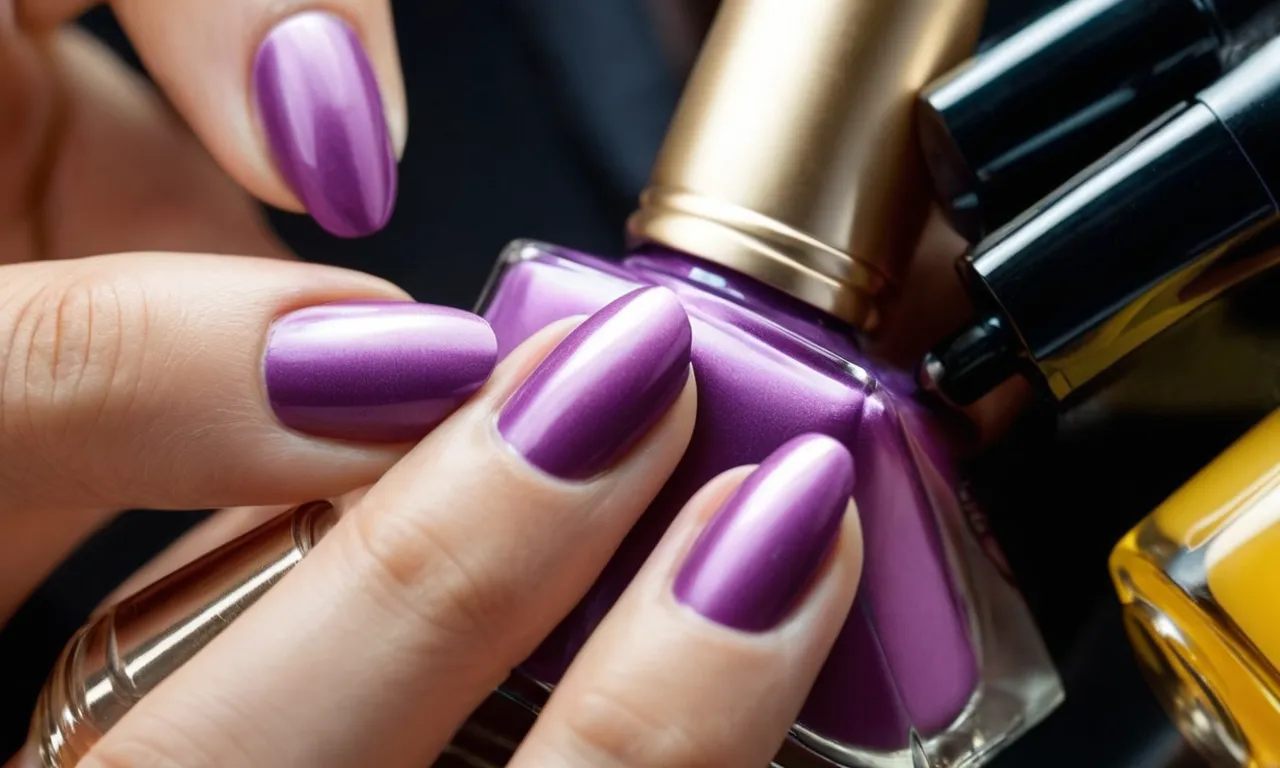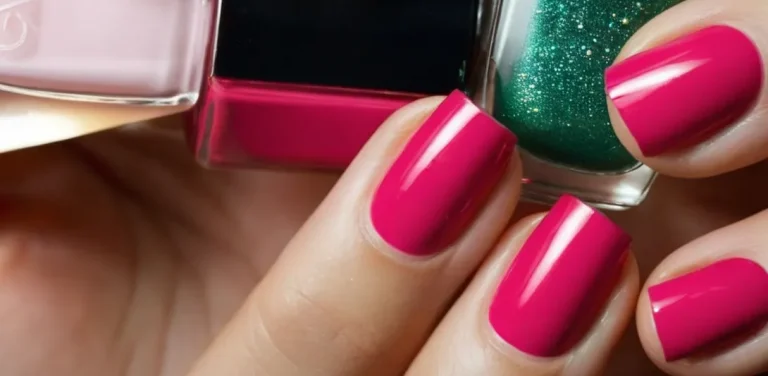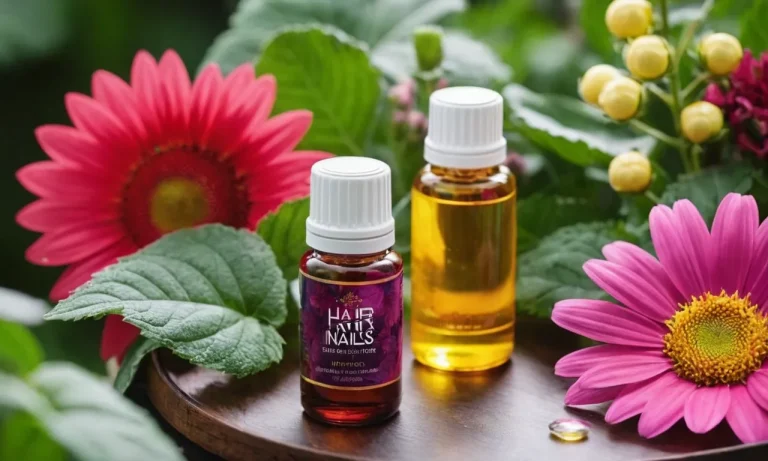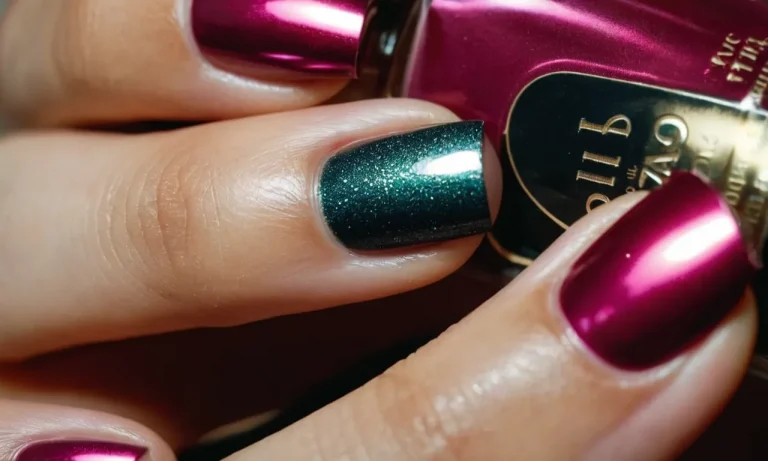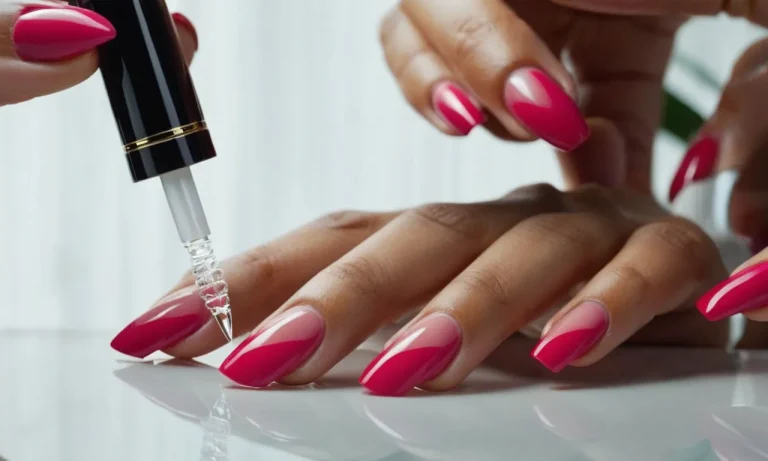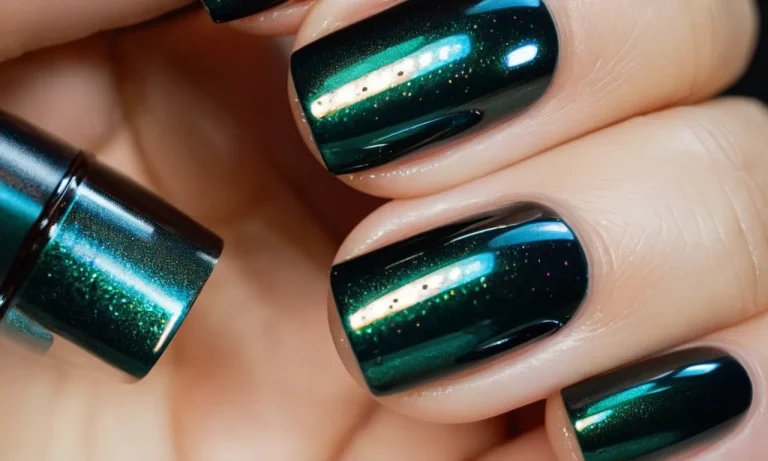How To Avoid Stained Nails From Nail Polish
Having beautifully manicured nails can make you feel put together, but the sight of stained nails the morning after a DIY manicure can be disheartening. If you’ve ever peeled off chipped nail polish only to find yellow, brown or even green stains on your nails, you know how unsightly these stains can be.
If you’re short on time, here’s a quick answer to your question: Use a base coat under darker polishes and avoid cheaper polishes with harsh ingredients. Gently buff stained nails and use lemon juice or whitening toothpaste to lighten stains.
In this comprehensive guide, we’ll cover why nail staining happens, how to prevent it, and what to do if you already have stained nails so you can get back to beautiful, pristine nails.
What Causes Nail Staining
Dark Nail Polishes
Dark colored nail polishes, especially dark reds, browns, blacks, and purples contain pigments that can penetrate and stain the nails (1). Even with a base coat, these pigments can become trapped under the nail plate and leave residual color.
The more coats of dark polish applied, the deeper it penetrates. Frequent use of dark nail polish without allowing breaks in between can compound this effect. Removing dark polishes thoroughly with acetone-free remover and avoiding painting the nails and cuticles can help minimize staining.
Low-Quality Nail Polishes
Cheap nail polishes are more prone to cause staining because they contain lower grade pigments with poor binding chemicals (2). Higher quality brands use pigments that sit on the surface of the nail better without sinking in.
When budget is a concern, spending a little more for a mid-range polish that’s non-toxic and “3-free” (without the chemicals toluene, formaldehyde, and dibutyl phthalate) can make a difference. Always use a base coat under color with low-cost polishes.
Yellowing from Age
Nails naturally develop a yellowish tint with age as the nails thicken and get less translucent (3). Certain medical conditions, medications, and habits like smoking can also yellow nails over time. Using nude and blush toned polishes can help camouflage yellowing.
An occasional break from all nail polish allows fresh, new nail growth to renew the nail plate. If excessive yellowing occurs, consulting a dermatologist to rule out fungal infection or other causes may be wise.
While stained nails are harmless, they are unsightly. Understanding what causes staining and taking some preventive measures allows fashionable nails to stay looking their best for longer.
References:
- https://www.medscape.com/answers/1076321-16596/what-causes-nails-to-become-stained-after-using-dark-colored-nail-polish
- https://www.nails.net/blog/nail-polish-staining-fingernails/
- https://www.healthline.com/health/yellow-nails#causes
How to Prevent Nail Staining
Use a Base Coat
Applying a base coat before painting your nails is one of the best ways to prevent staining. The base coat creates a protective barrier between your nail and the polish, making it less likely that pigments will soak into the nail bed. Look for a base coat specifically formulated to prevent staining.
Many base coats contain ingredients like formaldehyde resin that seal the nail. Using a base coat under both dark and light colored polishes is a good idea.
Avoid Certain Ingredients
Some ingredients are more likely to cause nail staining than others. Darker pigments like black, blue, green, and purple are notorious for leaving behind stains. Metallic polishes can also discolor nails with long-term use.
When possible, choose nail polish containing natural pigments over synthetic pigments. Chemical dyes tend to soak into nails more readily. Steer clear of nail polishes listing tributyl acetyl citrate, triphenyl phosphate, stearalkonium bentonite, and formaldehyde resin in the ingredients as these can bind to nails.
Choose High-Quality Polishes
High-end nail polishes are less likely to stain nails than cheap varieties. Invest in salon-quality lacquers with a smooth, easy to apply formula. Thin watery polishes seep into nail beds more readily. Look for an opaque polish that glides on evenly and fully covers nails in 1-2 coats.
Quality polish brands like OPI, Essie, and Zoya tend to have better, less staining formulas. Drugstore brands can be hit or miss when it comes to preventing stains.
Don’t Skimp on Removal
Taking the time to properly remove nail polish is crucial for avoiding stains. Never pick or peel off polish as this can damage nails and allow more stain-causing pigment to penetrate. Use acetone-based nail polish remover and cotton balls to gently dissolve polish off nails.
Make sure to moisturize nails after removing polish to counteract the drying effects of remover. Allow nails to go polish-free once a week to give them a break and prevent buildup.
How to Remove Existing Nail Stains
Gently Buff Away Stains
One of the easiest ways to remove light stains from nails is to gently buff them away. Using a nail buffer or emery board, lightly go over the stained area using short back-and-forth motions. Apply light pressure and buff just until the stain fades.
Be careful not to over-buff or you may thin out the nail. For tougher stains, try buffing in conjunction with a nail whitening product. With regular buffing and nail care, you can keep nails looking stain-free.
Use Whitening Toothpaste
Believe it or not, whitening toothpastes contain mild abrasives that can help remove stubborn nail stains! Simply apply a small amount of whitening toothpaste to a soft toothbrush or nail brush and gently scrub the stained nails for 2-3 minutes. Rinse thoroughly.
For extra whitening power, look for toothpastes with ingredients like baking soda or hydrogen peroxide. The gritty texture combined with whitening agents help lift stains from nail plates. Just don’t overdo it, as too much scrubbing can damage nails.
Whitening toothpaste offers an easy, inexpensive way to clean up dingy nails.
Try Lemon Juice
Lemon juice is a natural lightener that can help reduce the appearance of yellow stains on nails. Due to its acidic nature, lemon juice works as a mild bleach to brighten stained nails. Simply soak a cotton ball in fresh lemon juice and rub it over stained nails.
Let it sit for 5 minutes before rinsing. For stubborn stains, you can also make a paste with lemon juice and baking soda and scrub onto nails using a soft brush. Rinse and moisturize nails after. Use this simple, natural method 1-2 times per week to lift stains without harsh chemicals.
Just beware that excessive use of lemon juice can dry out nails.
Use Hydrogen Peroxide
Hydrogen peroxide is another household staple that can remove discoloration on nails with regular use. It naturally bleaches nails while also disinfecting to keep nails healthy. Mix equal parts hydrogen peroxide and water and soak nails for 5-10 minutes. Rinse and pat dry.
Alternatively, dip a cotton swab in hydrogen peroxide and dab over stained areas of each nail. Let it sit for a few minutes before rinsing – you should see the stains lighten up. Use this nail cleansing treatment 1-2 times per week for best results.
Always dilute hydrogen peroxide to avoid drying out nails.
Consider Professional Whitening Treatments
For severely stained, discolored nails that won’t budge, professional whitening treatments may be the best solution. Nail salons offer intensive nail whitening services using powerful bleaches to dramatically brighten and even out the appearance of stained nails. Popular options include:
Salon whitening procedures are stronger than at-home methods to swiftly reveal brighter, clearer looking nails, sometimes in as little as one session. However, they are more expensive than DIY options.
Talk to your manicurist to decide the best professional whitening treatment for your particular type of stained nails.
When to See a Doctor About Nail Discoloration
If Stains Persist After Removal Attempts
Nail polish and other pigmented products can leave behind stubborn stains on nails that don’t go away easily. Try removing them with nail polish remover, gentle scrubbing, or filing off the stained layer of nail.
If those methods don’t work after a few attempts, it’s a good idea to see your doctor or dermatologist.
Persistent stains that resist removal could mean:
- There is deeper nail discoloration unrelated to products/stains
- An underlying nail condition is causing discoloration
- The stains have permeated deep into the nail layers
A doctor can properly diagnose the cause of lasting stained nails and provide appropriate treatment options. Leaving long-term stains untreated could lead to worsening of any underlying nail conditions.
If Nails are Discolored Along with Other Symptoms
Nail discoloration happening in conjunction with other nail changes or skin/health symptoms warrants an evaluation by a physician. Some examples of associated symptoms include:
- Nail crumbling, thickening, or detachment from nail bed
- Nail pitting, ridges, or grooves
- Red, swollen, or painful cuticles
- Pus drainage around nails
- Unexplained skin rashes or sores on fingers/hands
- Immune deficiencies
- Nutritional deficiencies
- Kidney, liver, or thyroid disorders
These types of concurrent symptoms suggest an underlying medical condition like nail fungus, skin infection,autoimmune disorder, vitamin/mineral deficiency, or systemic disease. It’s crucial to see a physician when other symptoms accompany nail staining so that any associated conditions can be properly diagnosed and treated.
If Nails are Yellow, Brown, Black, or Have Dark Lines
While some types and degrees of nail discoloration are harmless, yellow, brown, black, or dark-striped nails warrant medical assessment. These specific changes can signify:
- Fungal infection
- Bacterial infection
- Melanoma (rare but serious skin cancer)
- Vitamin or mineral deficiency
- Thyroid disorders
- Liver or kidney dysfunction
- Diabetes
- Medication side effects
- Heavy metal poisoning
Since many of these causes of dark nail staining can indicate underlying health conditions, it’s wise to make an appointment with your doctor. Early diagnosis and treatment of any problems is key.
Your physician can examine your nails and ask about your health history to determine if any testing is needed. Based on the likely cause, blood tests, imaging scans, nail clippings/scrapings, or biopsy may be done to reach an accurate diagnosis. Proper treatment can then begin.
Conclusion
Having beautifully polished nails can make you feel confident and put-together, but unsightly stains can quickly ruin the look. By taking some simple precautions and using the right removal techniques, you can avoid post-manicure stained nails.
Invest in quality polishes, always use a base coat, and gently buff away any stains that do occur. With the tips in this comprehensive guide, you’ll be sporting gorgeous, pristine nails every time you paint them.

